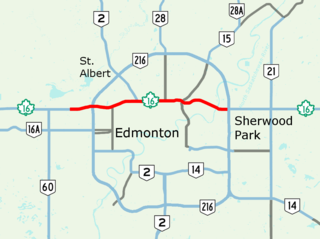Belvedere is a residential neighbourhood in north east Edmonton, Alberta, Canada. It is located on the west side of the Canadian National Railway right of way close to the Belvedere LRT station.
Bannerman is a residential neighbourhood in the Clareview area of north east Edmonton, Alberta, Canada. It is named after "H. Bannerman, who settled in the Belmont area in 1883."
Belmont is a residential neighbourhood located in the Clareview area of north east Edmonton, Alberta, Canada.
Sifton Park is a residential neighbourhood in the Clareview area of north east Edmonton, Alberta, Canada. The neighbourhood was named for Arthur Sifton, who served as the second premier of Alberta from 1910 until 1917.
Kernohan is a residential neighbourhood located in the Clareview area of north east Edmonton, Alberta, Canada. It is "named for an early pioneer farmer who operated a grocery store here in the 1880s and 90s.
Canon Ridge is a residential neighbourhood in the Hermitage area of north east Edmonton, Alberta, Canada that was mostly built up in the 1950s.
Overlanders is a residential neighbourhood in the Hermitage area of northeast Edmonton, Alberta, Canada.
Homesteader is a residential neighbourhood in the Hermitage area of north east Edmonton, Alberta, Canada.

Yellowhead Trail is a 24.6-kilometre (15.3 mi) expressway segment of the Yellowhead Highway in northern Edmonton, Alberta, Canada. It carries a significant amount of truck traffic to and from the industrial areas of north Edmonton and serves as a key commuter route for the bedroom communities of Stony Plain, Spruce Grove, and Sherwood Park, carrying nearly 80,000 vehicles per weekday in 2015. A suburban bypass of the route was completed when the northeast leg of Anthony Henday Drive (Highway 216) opened in late 2016, providing an alternate route through north Edmonton.
Patricia Heights is a neighbourhood in west Edmonton, Alberta, Canada. It is bounded by the Patricia Ravine of the North Saskatchewan River valley and ravine system to the south and southwest, the Westridge neighbourhood to the west, the Elmwood and Lynnwood neighbourhoods across Whitemud Drive to the north, and the Rio Terrace neighbourhood across 156 Street to the east.
Big Lake is a residential area in the northwest portion of the City of Edmonton in Alberta, Canada. It was established in 1991 through Edmonton City Council's adoption of the Big Lake Area Structure Plan, which guides the overall development of the area.
Casselman-Steele Heights is a residential area in the northeast portion of the City of Edmonton in Alberta, Canada. Though development had already commenced in a portion of the area, its extents were established in 1972 through Edmonton City Council's adoption of the Casselman-Steele Heights District Outline Plan, which guided the overall development of the area.
Clareview is a residential area in the northeast portion of the city of Edmonton in Alberta, Canada. It was established in 1972 through Edmonton City Council's adoption of the Clareview Outline Plan, which guides the overall development of the area. Clareview station is the northern terminus of the Edmonton Light Rail Transit.
Pilot Sound is a residential area in the northeast portion of the City of Edmonton in Alberta, Canada. It was established in 1981 through Edmonton City Council's adoption of the Pilot Sound Area Structure Plan, which guides the overall development of the area.
Windermere is a residential area in the southwest portion of the City of Edmonton in Alberta, Canada. It was established in 2004 through Edmonton City Council's adoption of the Windermere Area Structure Plan, which guides the overall development of the area.
Riverview is a residential area in the west portion of the City of Edmonton in Alberta, Canada. It was named on December 11, 2012, and was then formally established on July 3, 2013 through Edmonton City Council's adoption of the Riverview Area Structure Plan, which guides the overall development of the area. The area is estimated to have a population of 48,483 at full build-out of five neighbourhoods.
Horse Hill is a residential area in the northeast portion of the City of Edmonton in Alberta, Canada. It was formally established on May 22, 2013 through Edmonton City Council's adoption of the Horse Hill Area Structure Plan, which guides the overall development of the area. The area is estimated to have a population of 71,467 at full build-out of five neighbourhoods.

